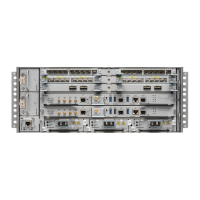PurposeCommand or Action
Configures the specified interface to send NTP broadcast packets.
broadcast [destination ip-address] [key key-id]
[version number]
Step 6
Go to 5 to configure the interface to receive NTP broadcast
packets.
Note
Example:
RP/0/RP0/CPU0:router(config-ntp-int)#
broadcast
destination 10.50.32.149
Saves configuration changes.Use one of the following commands:
Step 7
•
end
•
When you issue the end command, the system prompts you
to commit changes:
Uncommitted changes found, commit them before
•
commit
Example:
RP/0/RP0/CPU0:router(config-ntp-int)# end
exiting(yes/no/cancel)?
[cancel]:
◦
Entering yes saves configuration changes to the running
configuration file, exits the configuration session, and
returns the router to EXEC mode.
or
RP/0/RP0/CPU0:router(config-ntp-int)#
commit
◦
Entering no exits the configuration session and returns
the router to EXEC mode without committing the
configuration changes.
◦
Entering cancel leaves the router in the current
configuration session without exiting or committing the
configuration changes.
•
Use the commit command to save the configuration changes
to the running configuration file and remain within the
configuration session.
Configuring NTP Access Groups
No specific command enables NTP; the first NTP configuration command that you issue enables NTP.Note
The access list-based restriction scheme allows you to grant or deny certain access privileges to an entire
network, a subnet within a network, or a host within a subnet. NTP communication consists of time requests
and control queries. A time request is a request for time synchronization from an NTP server. A control query
is a request for configuration information from an NTP server.
The access group options are scanned in the following order, from least restrictive to most restrictive:
System Management Configuration Guide for Cisco NCS 5000 Series Routers, IOS XR Release 6.2.x
151
Implementing NTP
Configuring NTP Access Groups

